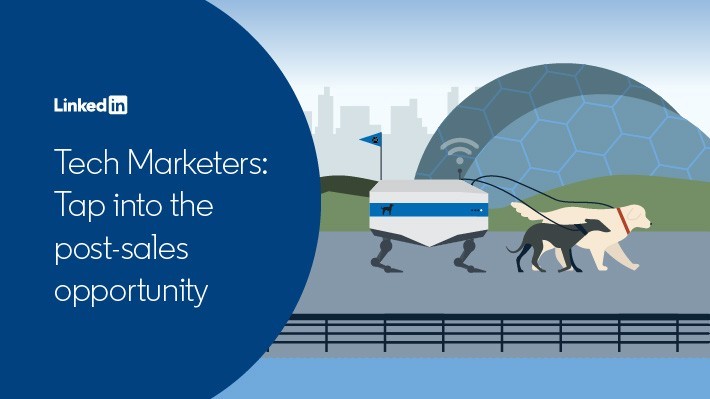Post-sales support is the big untapped opportunity of tech marketing
Customer expectations are constantly rising, with demand for products and services that are faster, more convenient, more intuitive and more personalised. Brands must stay alert to keep up.
B2B tech vendors are no different, with the latest LinkedIn Technology Buyers Report - The Age of Agility 20/21, a survey of 2,000+ tech buyers across Europe, the Middle East and Africa, revealing that more than half of all buyers (56%) say that post-sales support is a major factor behind which vendor they choose. As budgets get squeezed, it’s no longer enough for a solution to ‘do the job’. Today, tech buyers expect vendors to go above and beyond in delivering return-on-investment (ROI) and continuing to add value. Get it right and you’ll feel the benefit in sales, retention, acquisition spend, and creating advocates for your brand.
Yet despite its importance, Forrester has reported that there are no clear leaders in the customer experience (CX) space, meaning this is open space that is up for grabs. How can tech marketers ensure their post-sales support doesn’t just meet, but exceeds customer expectations?
Minimise time-to-value
According to The Age of Agility report, implementation can take nearly six months in enterprise companies – a lengthy process in a fast-moving world. Marketers have a critical role to play in streamlining this process and exploring ways to minimise time-to-value, starting before a contract is signed and continuing into the implementation phase itself.
Marketing needs to ensure that clients have full transparency of product features, implementation times, outcomes, and time to ROI before they sign on the dotted line, while sales teams should begin a dialogue about which areas should be prioritised during onboarding. This ensures that expectations are aligned, and that the most important functionality can be up and running as soon as possible.
“The (buyer) journey is getting longer and more complicated, but I see companies of all sizes benefiting when they focus on the shortest time to value for the client,” comments Hans A.T. Dekkers, VP Digital Sales at IBM. “Even if the processes are long and the sales cycles are long, how can you achieve the shortest time to value within that? If you’re selling an AI engine - how can you provide that AI in the fastest way possible and then start the rest of the process after that?”
Help clients to do more
This focus on delivering ROI should continue post implementation, to ensure that clients are continuously getting the most out of the product or service. Data-based recommendations from marketing will empower sales and customer services teams to help their clients maximise the value they are getting from the products/services. This is something that Microsoft France is already doing successfully.
“It’s the core way that we measure ROI today,” says Sébastien Imbert, CMO, Microsoft France. “We can see the accounts with high, medium and low engagement on different solutions, and so we can provide specific direction and insights to sales. If a customer is highly engaged on Dynamics 365 but there’s no correlation in terms of pipeline, then we can go to sales and ask, ‘how can we help?’ When we have piloted this approach, we see an impact within months.”
Listen and be responsive
As well as supporting clients with challenges specifically related to products and services, vendors should also be looking for broader ways to show their value. At Salesforce, supporting businesses is a core part of their strategy, as it demonstrated when it launched Salesforce Care Small Business Grants during Covid-19 to help its customers to ride out the economic downturn. This kind of approach requires responsiveness, through listening to customer needs, drawing on data, and keeping a close eye on the business landscape.
“Speed is the currency for marketing right now,” says Ashling Kearns, CMO EMEA, Salesforce. “What’s been really useful is the ability to move fast, work in sprints and develop things in the moment that are relevant to customers. Our value of innovation has really shown up this year – and we’ve been able to innovate like that because we’re listening to customers so deeply.”
Furthermore, initiatives like this are only possible through uniting the whole organisation around the importance of the customer experience, something that marketing has a leading role in orchestrating.
“Aligning with sales is one component, but as B2B marketers, our task should really be to align every department,” continues Ashling. “We can play this beautiful role as an orchestrator bringing all parts of the organisation together around the common cause that is the customer.”
Closing the circle: great post-sales support IS great marketing
Post-sales support will not just aid retention and loyalty, but will go full circle, by paying huge dividends at the top of the marketing funnel too. Case studies - to showcase customer success and relevant proof points - are one of the most effective marketing tools available. Co-marketing campaigns with clients is another way of helping them to feel valued and enhance those relationships.
“One of the first things we did after launching the brand (NTT Ltd.) was go out and find these amazing stories of things we were already doing for customers and partners around the world,” says Ruth Rowan, CMO, NTT Ltd. “Part of the power of marketing is finding those magic nuggets and bringing them to life.”
The days when marketing and sales disengaged after a contract was signed are well and truly over. Today, the customer experience is a holistic process, with everybody playing a role throughout the whole journey. And marketing is at the forefront, bringing all the pieces together to ensure that customers have just what they need, and more, at every touchpoint.
The LinkedIn B2B Technology Buying Survey – Age of Agility EMEA Report 20/ 21 lays out the five key trends in a new and dynamic landscape for technology marketers. Discover what your buyers need from you today.
Topics: Account-based marketing Targeting and audience building Measurement and ROI LinkedIn Ads
Related articles



